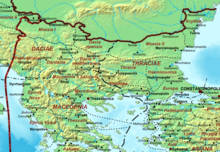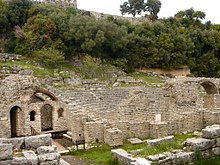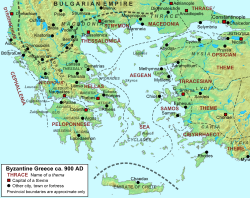Epirus (Roman province)
| Provincia Epiri Ἐπαρχία Ἠπείρου | |||||||||||||||
|---|---|---|---|---|---|---|---|---|---|---|---|---|---|---|---|
| Provinceof theRoman Empire | |||||||||||||||
| 100s or 110s AD–7th century | |||||||||||||||
 The province of Epirus within the Roman Empire, c. 125 AD | |||||||||||||||
| Capital | Nicopolis | ||||||||||||||
| Historical era | Antiquity | ||||||||||||||
• Established | 100s or 110s AD | ||||||||||||||
| 7th century | |||||||||||||||
• Transformed into theTheme of Nicopolis | 7th century | ||||||||||||||
| |||||||||||||||
| Today part of | Greece Albania | ||||||||||||||
The province ofEpirus(Latin:Provincia Epiri,Ancient Greek:Ἐπαρχία Ἠπείρου,romanized:Eparchía Ēpeírou) was aprovinceof theRoman Empire,covering the region of AncientEpirus.Rome first annexed the region in 167 BC, in the aftermath of theThird Macedonian War,and initially put the region in the largerRoman province of Macedonia,which at the time covered the whole of the Hellenistic world in mainland Europe. In 27 BC, Epirus andAchaeawere separated from Macedonia and grouped into thesenatorial provinceofAchaea,with the exception of its northernmost part, which remained part of the province of Macedonia.[1]Under EmperorTrajan,sometime between 103 and 114 AD, Epirus became a separate province, under aprocuratorAugusti.The new province extended from the Gulf of Aulon (Vlorë) and theAcroceraunian Mountainsin the north to the lower course of theAcheloos Riverin the south, and included the northern Ionian Islands ofCorfu,Lefkada,Ithaca,Cephallonia,andZakynthos.[1]
History[edit]
Rome had maintained a military presence in Epirus since theFirst Macedonian War,when it used Epirus as an entry-point for Roman troops in Greece. Rome would continue to use Epirus as a gateway for its troops in theSecondandThird Macedonian Wars.During the third war, the hitherto neutralEpirote Leaguesplit, with theMolossianssiding with theMacedoniansand theChaoniansandThesprotianssupporting the Romans.[2]The war ended disastrously for Epirus: 150,000 Molossians were enslaved and the region fell to Rome.
The status of the region between 167 and 146 BC is unclear, but in 146 BC, it was grouped in the largerRoman province of Macedonia.DuringCaesar's Civil War,Julius CaesarusedBouthrotonas a naval base, and later drew up plans for acoloniathere for his civil war veterans shortly before his death.Augustuslater took up these plans and made the city a colony for his own veterans, after his victory overMark Antonyat theWar of Actium.[3]New residents expanded the city and the construction included anaqueduct,thermae,houses, aforumcomplex and anymphaeum.During this period, the size of the town was doubled.[4]A number of new structures were built next to the existing ones, especially around the theatre and the temple ofAsklepios.[5]
Augustus also separated Epirus and Achaea from Macedonia in 27 BC, but it remained part of the province ofAchaiauntil sometime between 104 and 117 AD, whenTrajanmade it a province in its own right.[1]
Epirus VetusandEpirus Nova[edit]

Sometime during the provincial reorganization byDiocletian(r. 284–305), the western portion of the province of Macedonia along the Adriatic coast was split off into a new province, called "New Epirus" (Latin:Epirus Nova) which roughly corresponded to southernIllyriaproper, historically inhabited byIllyrian tribes.Epirus proper thereafter became known as "Old Epirus" (Latin:Epirus Vetus,Ancient Greek:Παλαιὰ Ἤπειρος).
Late Antiquity[edit]
The two Epirote provinces became part of theDiocese of Moesia,until it was divided in ca. 369 into the dioceses ofMacedoniaandDacia,when they became part of the former.[6]In the 4th century, Epirus was still a stronghold ofpaganism,and was aided by EmperorJulian(r. 361–363 AD) and hispraetorian prefectClaudius Mamertinusthrough reduction in taxes and the rebuilding of the provincial capital,Nicopolis.[7]According toJordanes,theVisigothsraided the area in 380.[7]With the division of the Empire on the death ofTheodosius Iin 395, Epirus became part of the Eastern Roman orByzantine Empire.[7]In 395–397, the Visigoths underAlaricplundered Greece. They remained in Epirus for a few years, until 401, and again in 406–407, during Alaric's alliance with theWestern RomangeneralissimoStilichoin order to wrestEastern Illyricumfrom the Eastern Empire.[7]

From 467 on, the Ionian Islands and the coasts of Epirus became subject to raids by theVandals,who had taken over theNorth Africanprovinces and established their own kingdom, theKingdom of the Vandals,centred onCarthage.The Vandals seized Nicopolis in 474 as a bargaining chip in their negotiations with EmperorZeno,and plundered Zakynthos, killing many of its inhabitants and capturing many others and taking them into slavery.[8]Epirus Nova became a battleground during the power struggles of theOstrogothsafter 479, in which the Byzantines were involved.[8]A Gothic attempt to take Durrës was repulsed by Roman forces during this period.[9]
In 517, a raid of theGetaeorAntaereached Greece, including Epirus Vetus.[8]Procopius of Caesareaclaims in hisSecret Historythat underJustinian I(r. 527–565 AD), the entirety of the Balkan provinces was raided by barbarians every year. However, this is considered rhetorical hyperbole by modern scholars, as only a single Slavic raid to the environs of Dyrrhachium, in 548–9, has been documented.[8]Procopius further reports that in 551, the Ostrogothic kingTotilasent his fleet to raid the shores of Epirus, in an attempt to interdict the Byzantines' lines of communication with Italy during theGothic War,in which the Byzantines were trying to annex his kingdom.[10]In response to these raids, and to repair the damage done by two destructive earthquakes in 522, Justinian initiated a wide-ranging programme of reconstruction and re-fortification: Hadrianopolis was rebuilt, albeit in reduced extent, and renamed Justinianopolis, whileEuroeawas moved further inland - this has been traditionally identified with the founding ofIoannina.Procopius also claims that no less than 36 smaller fortresses in Epirus Vetus—most of them not identifiable today—were either rebuilt or built anew.[10]
Loss and Byzantine reconquest[edit]

In the late 6th century, much of Greece, including Epirus, fell under the control of theAvarsand their Slavic allies. This is placed by theChronicle of Monemvasiain the year 587, and is further corroborated by evidence that several sees were abandoned by their bishops by 591. Thus, inc. 590the bishop, clergy and people of Euroea fled their city, carrying with them the relics of their patron saint,St. Donatus,to Cassiope in Corfu.[11]
The restoration of Byzantine rule seems to have proceeded from the islands, chiefly Cephallonia, which was certainly under firm Imperial control inc. 702,whenPhilippicus Bardaneswas banished there. The gradual restoration of Imperial rule is evidenced further from the participation of local bishops in councils inConstantinople:whereas only the bishop of Dyrrhachium participated in the Ecumenical Councils of680–1and692,a century later the bishops of Dyrrhachium, Nicopolis, Corfu, Cephallonia, and Zakynthos are attested in theSecond Council of Nicaeain 787.[12]
In about the middle of the 8th century, theTheme of Cephalleniawas established; this, along with theTheme of Nicopolis,which was established in the 9th century, covered the former region of Epirus Vetus. TheTheme of Dyrrhachium,established in the 9th century, covered what was once Epirus Nova, and Byzantine rule in Epirus in the early Middle Ages would continue through these new provinces.[13][14][15][16]
Economy[edit]
The province, especially the northern towns, benefitted greatly from the construction of theVia Egnatiato the north.[17]Due to both its traditionally reputed livestock and its proximity to the Italian peninsula, Epirus became a major exporter ofcattleand luxury goods like racehorses to Italy, where the latter were in great demand for the popularchariot racesin Rome.[18]
Epirus also had significant populations of Italian settlers with large estates, attracted by the potential for pastoral agriculture. It is possible that these settlers had significant impact on the demographics and commerce of the province.[19]
Cities and settlements[edit]
TheSynecdemusofHierocles,composed in ca. 527–8 AD but probably reflecting the situation in the first half of the 5th century, reports eleven cities for Old Epirus:
- Nicopolis, the capital
- Dodona
- Euroea
- Hadrianopolis
- Appon
- Phoenice
- Anchiasmos
- Buthrotum
- Photike
- Corfu Island
- Ithaca Island.
New Epirus, with its capital atDyrrhachium,comprised nine cities.[20]
Gallery[edit]
-
Roman theatre of Butrint
-
Roman amphitheatre of Dyrrachium
-
Early Christianbasilica,Butrint
-
Romannymphaeum,Nicopolis
-
A bastion ofDurrës Castle,built by EmperorAnastasius I Dicorus
-
Mosaicfrom the Roman Villa of Manius Antoninus, Nicopolis
References[edit]
- ^abcSoustal & Koder 1981,p. 47.
- ^"Epirus".Encyclopædia Britannica.Encyclopædia Britannica, Inc.Retrieved16 November2013.
- ^Walker & Wilkes 2010,p. 212.
- ^Hodges, Richard; Bowden, William; Lako, Kosta; Andrews, Richard (2004).Byzantine Butrint: excavations and surveys 1994–1999.Oxbow Books. p. 54.ISBN978-1-84217-158-5.Retrieved8 January2011.
- ^Cabanes, P. (1997)."From Alexander Molossus to Pyrrhus: Political Developments".Epirus, 4000 Years of Greek History and Civilization.Ekdotikē Athēnōn: 126.ISBN9789602133712.
"At Bouthrotos, it is enough to compare the theatre, built of grey poros, with all the Roman structures surrounding it: the skene and the neighbouring buildings, the new sanctuary of Asklepios and the areas next to it
- ^Soustal & Koder 1981,pp. 47–48.
- ^abcdSoustal & Koder 1981,p. 48.
- ^abcdSoustal & Koder 1981,p. 49.
- ^Wolfram 1988,pp. 271–274.
- ^abSoustal & Koder 1981,p. 50.
- ^Soustal & Koder 1981,p. 51.
- ^Soustal & Koder 1981,p. 52.
- ^Soustal & Koder 1981,p. 53.
- ^Nesbitt & Oikonomides 1991,p. 40.
- ^ODB,"Dyrrachion", (T. E. Gregory), p. 668.
- ^Pertusi 1952,p. 177.
- ^Walker & Wilkes 2010,p. 204.
- ^Eberle & le Quéré 2017,p. 41.
- ^Eberle & le Quéré 2017,pp. 40–42.
- ^Soustal & Koder 1981,pp. 48–49.
Sources[edit]
- Soustal, Peter; Koder, Johannes (1981).Tabula Imperii Byzantini, Band 3: Nikopolis und Kephallēnia(in German). Vienna:Verlag der Österreichischen Akademie der Wissenschaften.ISBN978-3-7001-0399-8.
- Eberle, Lisa Pilar; le Quéré, Enora (2017). "Landed Traders, Trading Agriculturalists? Land in the Economy of the Italian Diaspora in the Greek East".Journal of Roman Studies:107, 27–59.JSTOR26576044.
- Walker, Susan; Wilkes, John (2010). "Becoming Roman and staying Greek in the Southern Adriatic".Bulletin of the Institute of Classical Studies:197–212.JSTOR44214907.
- Kazhdan, Alexander,ed. (1991).The Oxford Dictionary of Byzantium.Oxford and New York: Oxford University Press.ISBN0-19-504652-8.
- Nesbitt, John;Oikonomides, Nicolas,eds. (1991).Catalogue of Byzantine Seals at Dumbarton Oaks and in the Fogg Museum of Art, Volume 1: Italy, North of the Balkans, North of the Black Sea.Washington, DC: Dumbarton Oaks Research Library and Collection.ISBN0-88402-194-7.
- Pertusi, A. (1952).Constantino Porfirogenito: De Thematibus(in Italian). Rome: Biblioteca Apostolica Vaticana.
- Wolfram, Herwig (1988).History of the Goths.Berkeley and Los Angeles: University of California Press.ISBN978-0-52006-983-1.
- States and territories disestablished in the 7th century
- Roman provinces in Europe
- Provinces of the Roman Empire
- 6th-century disestablishments in the Byzantine Empire
- Roman Epirus
- States and territories established in the 2nd century
- 110s establishments in the Roman Empire
- Greece under Roman rule
- Albania in the Roman era
- Epirus (Roman province)







